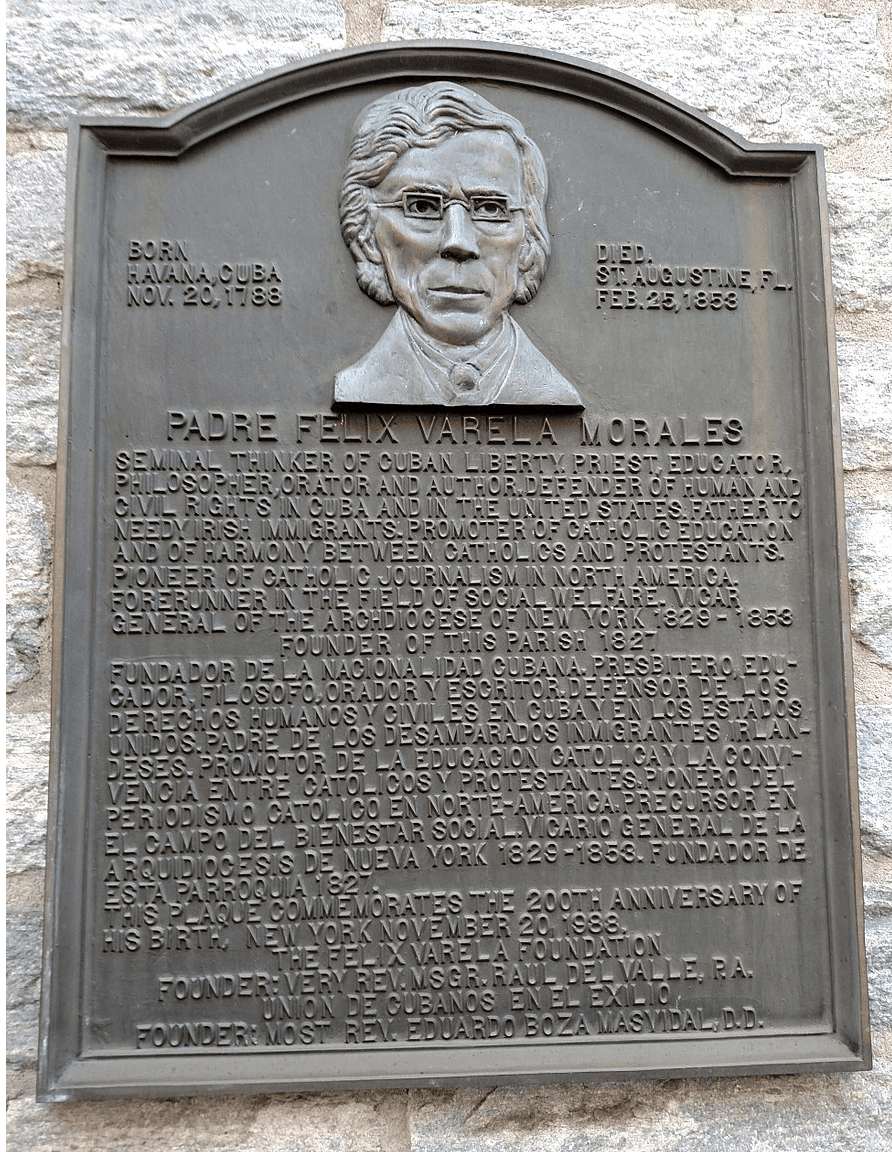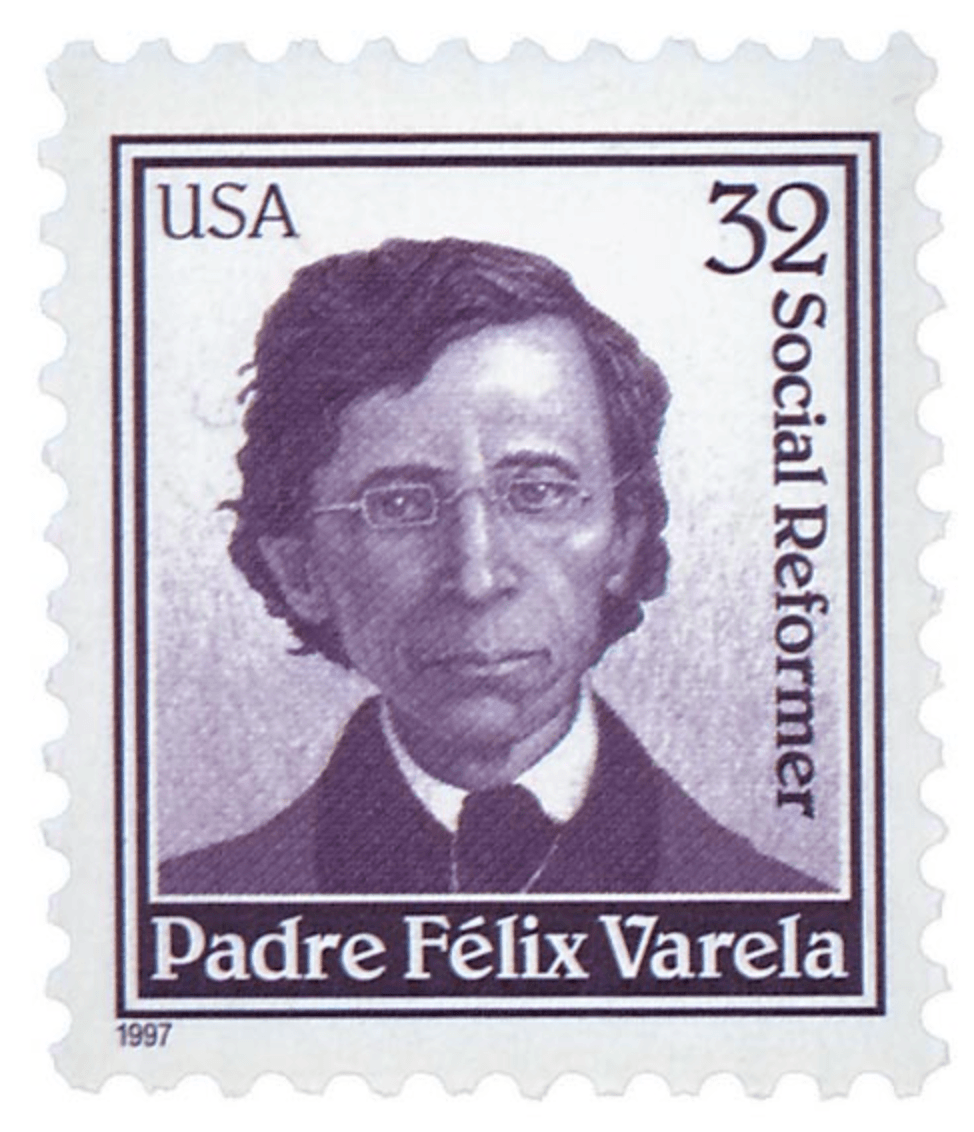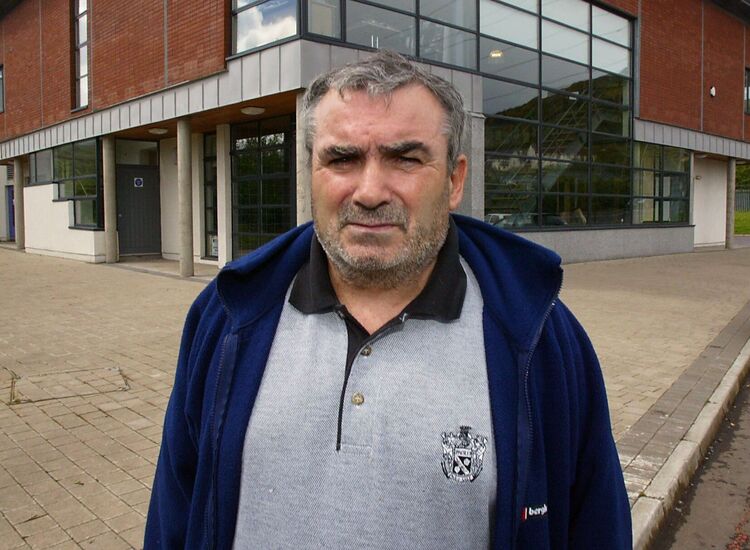In the 1820s and 1830s, no priest was more loved and revered by the Irish community than a Gaelic-speaking Cuban priest, the Rev. Félix Varela. Though many issues today separate Cuba and the United States, both countries still honor Fr. Varela. More than a century and a half after his passing, Cubans still revere him in Cuba for his patriotism, and New York honors him for his assistance to poor Irish immigrants. The contemporary journalist Juan Gonzales is among those who've praised the priest. He has written, “No Latino left a greater impact on 19th-century American culture than Varela.”
Born in Havana in 1787, Varela was orphaned at an early age and was still a child when he moved to St. Augustine, Florida, which was then Spanish territory. There he was entrusted to the care of his maternal grandfather, the commander of the city’s Spanish garrison. He became a student of Irish priest Father Michael O’Reilly, then vicar of East Florida, who eventually became his role model. Father O'Reilly influenced his decision to enter the priesthood rather than become a soldier, as his family traditions demanded. "I wish to be a soldier of Jesus Christ," Varela said at the time. "I do not wish to kill men, but to save their souls."
He returned to Cuba and began teaching philosophy in Havana and proved to be an extraordinary educator. Many future Cuban leaders were his students. He took radical positions, advocated giving women the same education as men and introduced many pedagogical innovations. Varela not only ended up transforming teaching throughout Cuba, but also thinking. His classroom was always more than a classroom: it was a place where Cubans were free to discuss the needs of their island. “This is the chair of freedom and human rights,” he proclaimed at a time when such words were forbidden and dangerous because the Spanish authorities suppressed any idea of Cuban freedom of thought.
In 1821, Varela was elected to the Spanish Cortes and traveled to Spain, where he recommended that the Spanish colonies in Latin America be considered independent. He also called for Cuban self-government and an end to slavery. He signed a document critical of Spanish King Ferdinand VII. The monarch declared the 66 signers of the document, including Varela, enemies of the state, putting him in danger of being executed. As a result, Father Varela fled Spain on a journey that would take him to the United States. He and his two companions arrived in New York Harbor aboard the "Draper" on Dec. 15, 1823, during a blizzard. Underdressed, Varela must have longed for his tropical homeland but return to Cuba would probably have meant death for him.
The New York City he arrived in was officially tolerant of Catholicism, but in reality, many of its residents were virulently anti-Catholic and they especially did not want to see poor Irish Catholic immigrants settle in New York, Varela, however, would dedicate his life to helping these unwanted immigrants.
At the time, there were only two parishes in New York: St. Peter's on Barclay Street and St. Patrick's Cathedral (now St. Patrick's Cathedral). Father John Power, vicar general of the diocese, asked Varela to help him organize a new immigrant community. Two years later, Fr. Varela raised $19,000 to purchase the Christ Church property. By 1833, that building was becoming unsafe for use. This prompted Varela to purchase land on James Street to build a new church dedicated to St. James. Some parishioners complained that James Street was too far from their former Christ Church. In response, Fr. Varela purchased an old Presbyterian church on Chambers Street. The church was renamed the Church of the Transfiguration. The church he founded was located in the poorest and most dangerous area of New York, the infamous Five Points, which many movie fans know as the setting of Martin Scorsese’s "The Gangs of New York" (2002).
The Irish lived in extreme poverty, crowded into small hovels often without running water. This crowded ghetto proved to be the perfect place for diseases like cholera to spread. During the cholera epidemic of 1832, according to a contemporary, Varela “practically lived in the hospitals.” He would greet immigrant ships, helping the penniless and often sick passengers who disembarked. Because of his love of people of all denominations, even those who despised Catholics, he was able to gain access to hospitals and other institutions other priests were denied access to, including the New York City Hospital, which was run by Protestants (but filled with Irish Catholic patients).
When he arrived, Father Varela, like many of his future parishioners, spoke little English. Many of the Irish in the Five Points communicated only in their native Irish language. Varela, a brilliant linguist, not only mastered English but also Irish Gaelic, which enabled him to understand the needs of his congregation and serve them better.

Fr. Varela is remembered in what was the Five Points district, now part of Chinatown, Downtown Manhattan.
The Cuban priest embodied the notion of altruism. His service to the poor and marginalized was immediate, direct, and deeply personal. Among Irish immigrants, many of whom came off the ships in desperate straits, Varela was known as a tireless advocate and defender. The immigrants came to love him deeply.
Over time, stories of his benevolence made him famous even though he shunned the spotlight. On one occasion, Varela was approached by a poor woman while eating his lunch. He excused himself for a moment, washed the spoon he was using, and handed it to her. “I have no money,” he is reported to have said. “But take this silver spoon, the last one I have left from my homeland: it will give you enough to feed your family.” The woman was later arrested on suspicion of stealing the spoon, and when Varela went to the police to answer for it, the incident appeared in the press.
In the book “Felix Varela: Torchbearer of Cuba, the authors describe his housekeeper’s “constant battle to supply him with the essentials. Everything she had on hand – his watch, his silverware, the dishes on his table, his bedclothes and blankets, his own clothes – he gave to the needy.” When people came seeking help, he “often served those who received alms through a side window or a back door.”
Valera came to America at a time when Catholicism was being denounced and Catholics were victims of sectarian violence. During this period, mobs burned Catholic churches, including in New York, but Varela proved to be one of the Church’s most effective speakers in defense of Catholicism and their faith. In 1830 and 1831, in addition to appearing on debate stages, he published a newspaper called the Protestant’s Annotator and Abridger, in which he patiently dissected every bigoted and perverse accusation written in the anti-Catholic newspaper called The Protestant.
While other Catholics leaders responded angrily to insults from the Church’s detractors, Varela was a peacemaker. “In an era of blinding religious animosities,” wrote biographers Joseph and Helen M. McCadden, “Varela was the pioneer ecumenist, able to engage in dialogue without violence, astonishing his opponents by his erudition and patient exposition.”
The Irish clamored for Varela to be their bishop, but Spain vetoed his selection because Varela continued to agitate for Cuban independence when in New York, creating, through his patriotic writings, a distinctive Cuban consciousness and nationality. At night, the priest also found time to write and edit El Habanero, a magazine for Cuban readers.
The rulers of Spain and Cuba feared the outspoken priest and still wanted him dead. In March 1825, an assassin landed in New York City, sent by associates of Francisco Vives, the colonial governor of Cuba. His instructions: kill Varela.
The priest received a warning letter. His friends in the Cuban expatriate community could learn the killer's identity, but not his whereabouts. They begged Varela to go into hiding, but he refused. Instead, he went about his work seemingly unfazed. He was not going to let threats divert him from his new mission of helping build the Catholic Church in America by ministering to the needs of its people. One day, walking the streets of his parish, the priest encountered the man who had been sent to assassinate him. In a spirit of compassionate forgiveness, he approached the would-be assassin and advised him not to commit a grave sin. The man listened. Then he returned to Cuba, his mission unfulfilled, while Varela continued his work alone, with hardly a pause.
By the late 1840s, Varela's health was failing. He had never fully adapted to the New York climate, and his respiratory problems became increasingly severe. Between 1847 and 1849, he suffered debilitating attacks of asthma and "consumption," so he traveled south to recuperate and then returned north with renewed vigor, resuming his daily rounds of visiting the sick and ministering to his flock.
In 1850, however, he left New York for the last time and moved to St. Augustine, Florida, where he had lived as a child. After three years of service to the people of St. Augustine, Father Felix Varela passed away in February 1853, surrounded by parishioners who sought his blessing or simply wanted to be in his presence. Among parishioners he was already considered a saint for his kindness and good works.
In 2012, Pope Benedict XVI gave his approval for Father Felix Varela to receive “venerable” status, following a unanimous recommendation by the Vatican’s Congregation for the Causes of Saints. This means that Varela is now eligible for beatification.
Although he is a revered figure in the United States, Cubans never forgot him. The great Cuban poet José Martí referred to him as “the eternal patriot,” Writer José Antonio Saco called him “the first Cuban,” and Cuban intellectual José de la Luz y Caballero honored him as “the first who taught us to think.” Today the parish he founded, the Church of the Transfiguration is in the heart of Chinatown and serves Chinese immigrants, but a plaque outside the church still honors this amazing Cubano who so loved his Irish congregation and New York’s poor.









